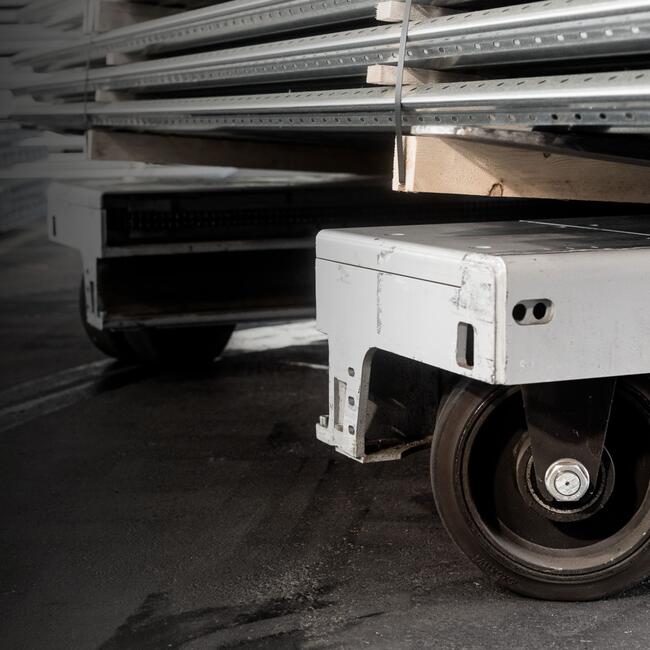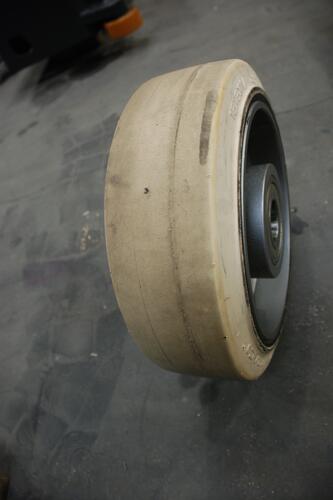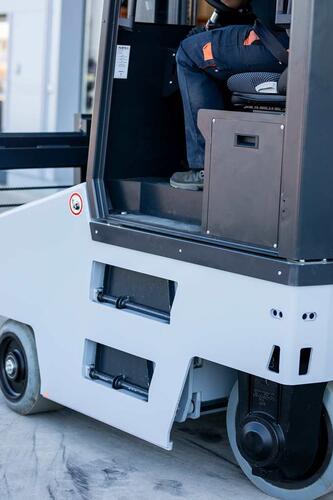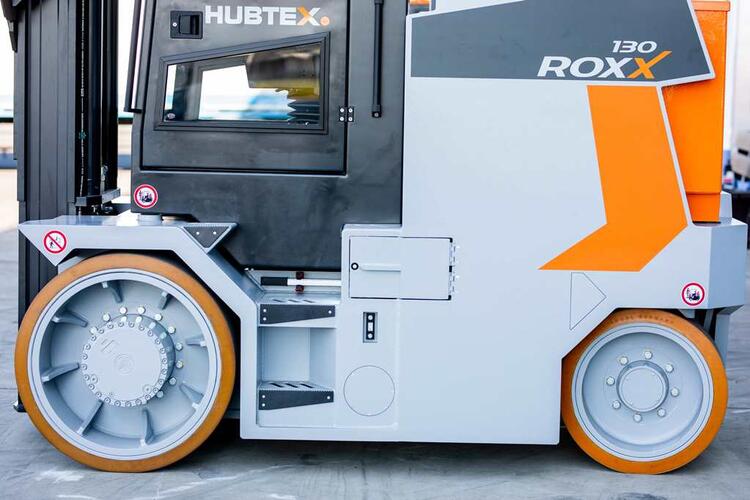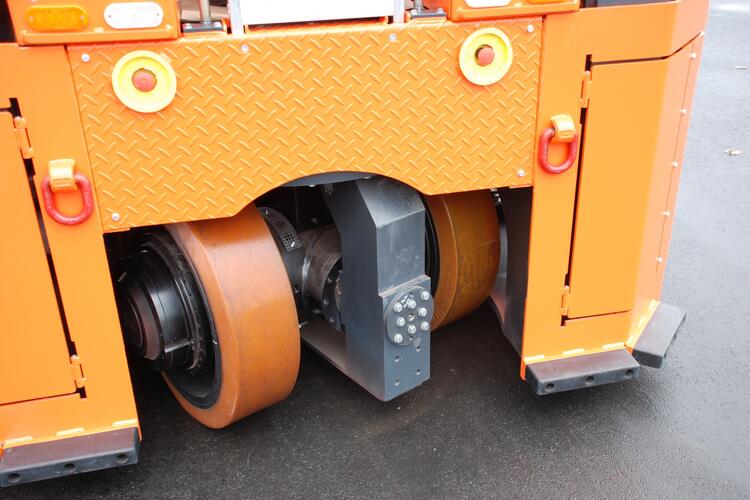Forklifts and industrial trucks can be used in many different ways. It is therefore very important to find the right forklift tires that are optimally designed for indoor or outdoor use. There are certain criteria that will serve as a useful guide.
What are the criteria for selecting forklift tires?
The first point to be determined is where and to what extent the forklift is to be used. The ground conditions, the subsoil and any gradients play a key role here. These factors determine whether or not the forklift tires require a profile. On smooth surfaces indoors there are usually fewer inclines and bumps than outdoors. Therefore, the driver can expect to encounter less vibrations or impacts. The experience is very different on smooth or wet surfaces outdoors. In this environment, a high-profile tire is essential.
Forklift tires – providing optimal comfort for truck drivers
Depending on whether there are differences in elevation or uneven ground, drivers may prefer to use tires with spring-like properties or a damping effect. It is also true that the heavier the load carried by the truck, the more stable the forklift tires must be. Other important factors to consider when choosing forklift tires are rolling resistance and driving wear. In general, reprofiled tires are low wear with high load capacity. This can provide a smooth driving experience. However, these forklift tires are not suitable for all ground conditions. In case of doubt, it is important to strike a compromise between the expected level of wear and driving safety when selecting forklift tires. Furthermore, resistance to external influences, cut resistance and puncture resistance are of vital importance. In many cases, resistance to chemicals or torque fluctuations is also worth considering.
The most popular types of tires
Standard pneumatic tires
Pneumatic tires are reinforced by a carcass. The contact surface is made of rubber. The tires are available in wide, normal and low-pressure variants. Since the low-pressure tires produce the lowest ground pressure, they are well suited to all-terrain industrial trucks.
Radial tires are designed for top speeds of up to 50 km/h. This is optimal for industrial trucks that also have to drive on public roads. The tires also combine low rolling resistance with high driving comfort.
Diagonal tires boast impressive dynamic stability as well as lateral stability. These forklift tires are ideal for all industrial trucks used at great lift heights.
The advantages of pneumatic tires include their flexibility and good suspension properties. They are therefore the optimal forklift tires for uneven outdoor surfaces. These tires also have good traction control and high mileage potential.
The disadvantage is that these forklift tires are relatively high maintenance. This is mainly due to the fact that the air pressure must be constantly monitored. They are also very susceptible to damage and there is always the possibility of foreign objects getting stuck in the profiling of the forklift tires. The point loading and floor loading of these forklift tires is low, yet the costs are sometimes very high.
(Super)elastic tires
Super-elastic tires are forklift tires filled with layers of elastic rubber. This means that the tires are harder than pneumatic tires but more elastic than solid rubber tires. There are numerous reasons to choose super-elastic tires. For example, they are very difficult to puncture, relatively maintenance-free and comparatively robust. They are often selected for their impressive suspension properties, which help to absorb shocks and vibrations. The load capacity of these forklift tires is moderate. However, the wear is usually significantly lower than with pneumatic tires. While the poor damping properties mean that the super-elastic tires are only suitable for off-road use to a limited extent. Both the rolling resistance and the fuel consumption are very high.
Polyurethane tires
Polyurethane tires are solid tires filled with fine-pored and flexible polyurethane foam. They have relatively good damping properties, which can ensure a high level of driving comfort. They also leave no marks on the road. The disadvantages include their high rolling resistance, higher fuel consumption and poorer damping properties than other types of tires such as pneumatic tires.
Solid tires
Solid tires are forklift tires that have a continuous and solid rubber surface that is fixed directly to the rim. They are robust and durable. However, the driving comfort is lower compared to other forklift tires. In addition, they are only suitable for maximum speeds of up to 20 km/h, which means that they are not suited or are only suited to a limited extent to driving on public roads. The high mileage potential and low wear are significant advantages, while their low suspension and low traction have a negative effect. Solid tires are almost maintenance-free, difficult to puncture and are well suited to industrial trucks working at greater lift heights.
What materials are forklift tires made of?
A brief overview of the primary tire materials and the temperature ranges in which they can be used can be found below:
- Natural rubber (NR): between -60 and + 65 degrees Celsius
- Styrene butadiene rubber (SBR): between -60 and +90 degrees Celsius
- Cross-linked polyurethane (PUR): between -30 and +100 degrees Celsius
- Polyamide 6 (PAG): between -30 and +90 degrees Celsius
- Polyamide 6.6 (PAG): between -45 and +90 degrees Celsius
- Polyurethane linear (TPU): between -40 and +100 degrees Celsius
What additional features are available for forklift tires?
Profiling
Forklift tires can be profiled or slick. Slick tires generally exhibit less wear. Profiled tires are subjected to more stress when turning the wheels on the spot and when changing direction than slick tires. There is also a risk that profiled tires flatten under load. This means that the profiling can shift sideways or be compressed. As a result, only a small area of the profiling is in contact with the ground when the truck is under load.
Pit stop line
The pit stop line shows the remaining life of a forklift tire. A colored band is incorporated inside the tire. As long as this band is not visible, there is still enough rubber left on the forklift tires.
Non-marking tires
Forklift tires, which are considered non-marking, leave no tracks or marks on the ground. They are mainly used indoors, as they protect the floor during the countless maneuvering processes.
Factors to note
What factors are important when using tires at high speeds or over long distances?
It is very important to pay attention to the heat build-up inside the wheel. In addition, depending on the wheel material, the thickness of the covering should be more than 25 mm.
How can the driving comfort of forklift tires be improved?
It is advisable to find a good compromise between the cushioning properties of the tire covering and the heat build-up. A covering thickness of 25 mm to 35 mm, depending on the wheel material, is optimal for this. For larger diameters of tire or if the truck is subject to high impacts due to uneven floors or fluctuating levels, a covering thickness of up to 40 mm is recommended. For the necessary covering thickness, the wheel material must always be taken into account.
